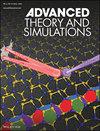Computational Exploration of Innovative Lead-Free DPs X2CdZnCl6 (X = Na and K) DFT Analysis of Optoelectronic, Mechanical and Thermoelectric Performance
IF 2.9
4区 工程技术
Q1 MULTIDISCIPLINARY SCIENCES
引用次数: 0
Abstract
Based on DFT computation, the physical properties of newlead-free double perovskites (DPs) X2CdZnCl6 (X = Na and K) is carried out within WIEN2K software. The measured formation energy (ΔEf) and tolerance factor indicate the cubic structure stabilities of investigated materials. The lattice parameters of the compounds Na2CdZnCl6 and K2CdZnCl6 are equal to 9.98 A° and 10.05 A°, respectively. The examination of the electronic structure through nKTB-mBJ demonstrates that lead free DPs X2CdZnCl6 (X = Na and K) exhibit semiconducting behavior with direct bandgap energy. The analysis of optical parameters reveal that the examined compounds have a stronger absorption property in UV region and make them well suited for photovoltaic devices and next-generation technologies. Additionally, using BoltzTrap code, the thermoelectric characteristics are thoroughly examined. The highest Seebeck coefficient values 218.32 and 254.29 µV K−1 for X = Na and K, respectively. According to calculations, the maximum ZT values of 0.7 for Na2CdZnCl6 and 0.73 for K2CdZnCl6 indicate their potential as promising materials for thermoelectric devices. The acquired figure of merit (ZT) values indictes that examined lead free DPs X2CdZnCl6 (X = Na and K) exhibit potential for implementation in thermoelectric devices.

创新无铅DPs X2CdZnCl6 (X = Na and K)的计算探索光电、机械和热电性能的DFT分析
基于DFT计算,在WIEN2K软件中对新型无铅双钙钛矿(DPs) X2CdZnCl6 (X = Na and K)的物理性质进行了研究。测量的地层能(ΔEf)和容差系数表明了所研究材料的立方结构稳定性。Na2CdZnCl6和K2CdZnCl6的晶格参数分别为9.98 A°和10.05 A°。通过nKTB-mBJ对电子结构的检测表明,无铅DPs X2CdZnCl6 (X = Na和K)具有直接带隙能量的半导体行为。光学参数分析表明,所检测的化合物在紫外区具有较强的吸收特性,使其非常适合光伏器件和下一代技术。此外,使用玻尔兹阱代码,热电特性进行了彻底的检查。当X = Na和K时,Seebeck系数最高值分别为218.32和254.29µV K−1。根据计算,Na2CdZnCl6的ZT最大值为0.7,K2CdZnCl6的ZT最大值为0.73,表明它们具有作为热电器件材料的潜力。所得的ZT值表明,所研究的无铅DPs X2CdZnCl6 (X = Na和K)具有在热电器件中实现的潜力。
本文章由计算机程序翻译,如有差异,请以英文原文为准。
求助全文
约1分钟内获得全文
求助全文
来源期刊

Advanced Theory and Simulations
Multidisciplinary-Multidisciplinary
CiteScore
5.50
自引率
3.00%
发文量
221
期刊介绍:
Advanced Theory and Simulations is an interdisciplinary, international, English-language journal that publishes high-quality scientific results focusing on the development and application of theoretical methods, modeling and simulation approaches in all natural science and medicine areas, including:
materials, chemistry, condensed matter physics
engineering, energy
life science, biology, medicine
atmospheric/environmental science, climate science
planetary science, astronomy, cosmology
method development, numerical methods, statistics
 求助内容:
求助内容: 应助结果提醒方式:
应助结果提醒方式:


